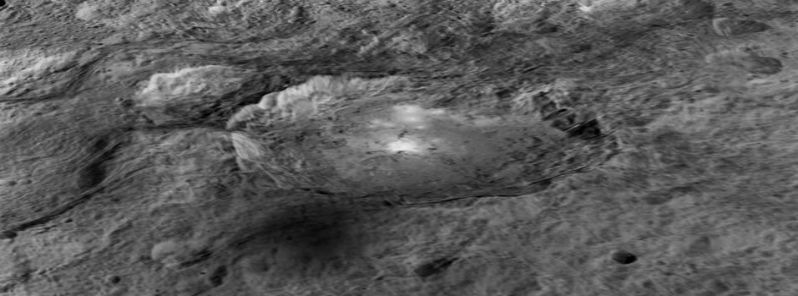Fascinating world of Ceres with its mysterious bright spots and a pyramid-shaped mountain

Dwarf planet Ceres continues to fascinate scientists with it’s pyramid like mountain and bright spots on its surface. NASA’s Dawn spacecraft, the first probe to reach this dwarf planet on March 6, 2015, continues to return images and other data of this mysterious planet that scientists analyze to learn more about it and develop ideas regarding our infant Solar System.
Tour weird Ceres: Bright spots and a pyramid-shaped mountain. Credit: NASA
The Dawn mission has been sent on a decade long mission to study asteroid Vesta and dwarf planet Ceres. Vesta is a dry, differentiated object with a surface that shows signs of resurfacing. On the other hand, Ceres has a surface primitive in nature with many similarities to the large icy moons in the outer Solar System. It is the largest object in the main asteroid belt between Mars and Jupiter, with a diameter of around 584 km (362 miles).
Scientists are now focusing on a prominent mountain with bright streaks on the planet's steep slopes. The peak of the mountain looks more like a cone or a pyramid, about 6 km (3.7 miles) above the surface. This means the mountain has about the same elevation as Mount McKinley in Denali National Park, Alaska, the highest point in North America.
"This mountain is among the tallest features we've seen on Ceres to date," said Dawn science team member Paul Schenk, a geologist at the Lunar and Planetary Institute, Houston.
The Occator crater, home to Ceres’ brightest spots, is also baffling scientists. A new animation in the video above demonstrates a close flyby of the crater. Scientists have found that it is not consistent with ice. The spots' albedo - a measure of the amount of light reflected - is also lower than predictions for concentrations of ice at the surface.
To carry out its scientific mission, Dawn carries a visible camera, a visible and infrared mapping spectrometer, and a gamma ray and neutron spectrometer.
The spacecraft will resume its observations of Ceres in mid-August from an altitude of around 1 500 km (932 miles) or three times closer to Ceres than its previous orbit.
Source: NASA
Featured image: Striking 3-D detail highlights a towering mountain, the brightest spots and other features on dwarf planet Ceres in a new video from NASA's Dawn mission. Credit: NASA.

Commenting rules and guidelines
We value the thoughts and opinions of our readers and welcome healthy discussions on our website. In order to maintain a respectful and positive community, we ask that all commenters follow these rules.